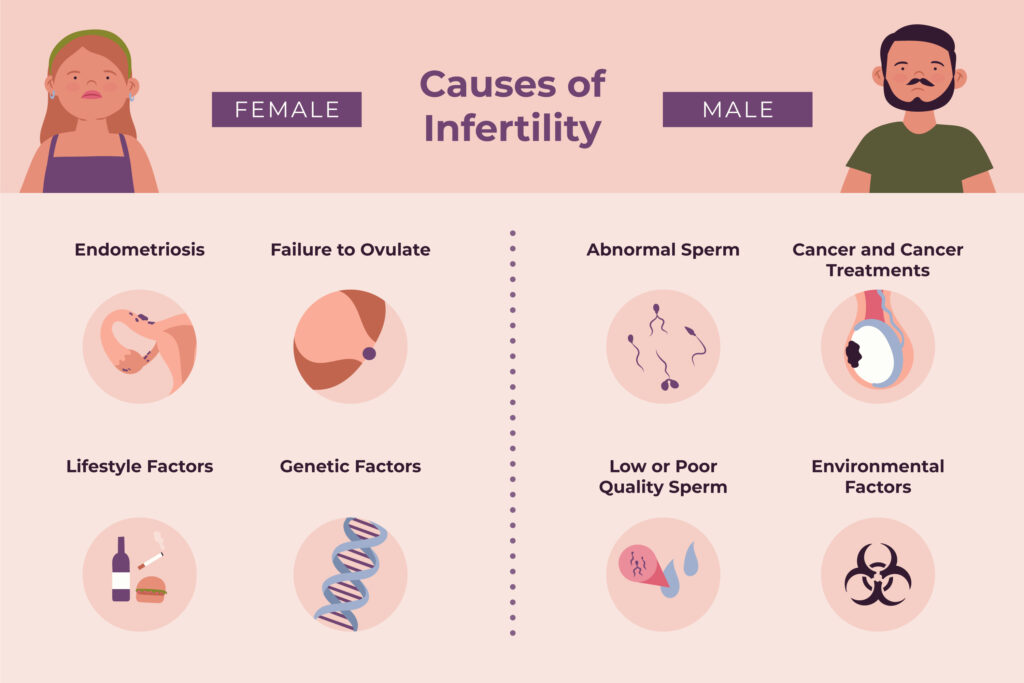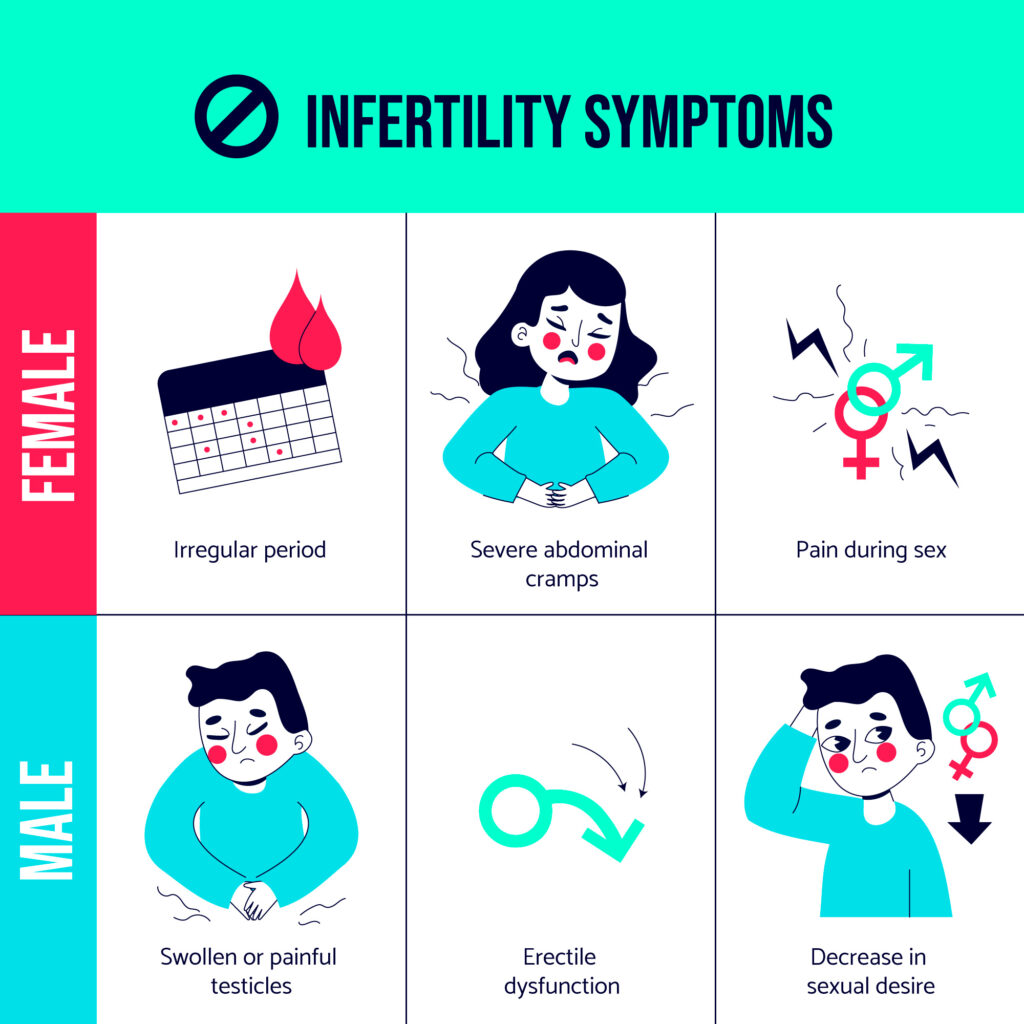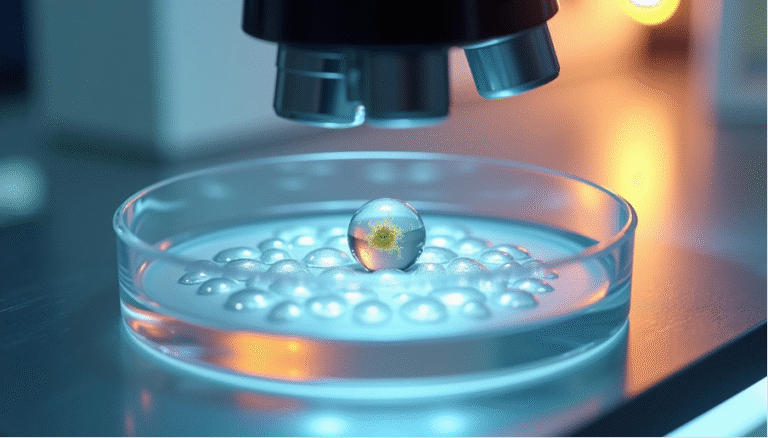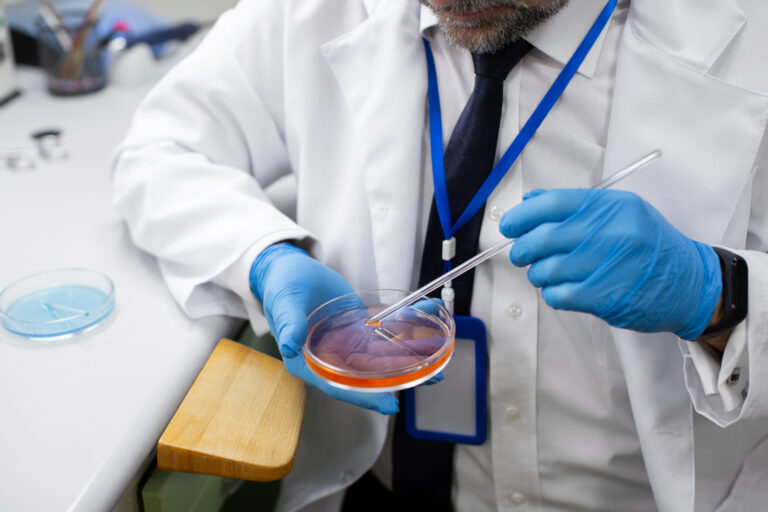Infertility is a disease of the male or female reproductive system defined by the failure to achieve a pregnancy after 12 months or more of regular unprotected sexual intercourse. Healthcare providers often start evaluation after 6 months of unsuccessful attempts if you have reached 35 years or older. The American Society for Reproductive Medicine describes infertility as a condition where pregnancy cannot be achieved based on a patient’s medical, sexual, and reproductive history, age, physical findings, diagnostic testing, or any combination of these factors.
This reproductive health condition affects countless people worldwide. About 9% of men and 11% of women of reproductive age have faced fertility problems in the India. One in 5 women between 15 and 49 years old struggle with primary infertility. On top of that, one in 20 women face secondary infertility. The global count shows 48 million couples live with infertility.

Infertility demonstrates itself in several distinct forms:
- Primary infertility: Happens when someone has never been pregnant and cannot conceive after one year (or six months if 35 or older) of regular, unprotected sexual intercourse.
- Secondary infertility: Describes the inability to get pregnant again after having at least one successful pregnancy.
- Unexplained infertility: Occurs when fertility testing hasn’t found a specific reason that a woman or couple cannot conceive.
Pregnancy achievement involves multiple complex steps. The brain produces reproductive hormones that control ovarian function. An egg matures in the ovary and releases during ovulation. The fallopian tube picks up the egg while sperm travels through the reproductive tract to reach and fertilize it. The resulting embryo then moves to the uterus where it implants. Problems at any stage of this process can lead to infertility. Male factors, female factors, or their combination can cause infertility. Sometimes doctors find no identifiable cause. Couples experiencing fertility problems might have multiple overlapping causes, with male factors being equally likely as female factors.
Women’s infertility may stem from tubal disorders like blocked fallopian tubes, uterine disorders such as endometriosis or fibroids, ovarian disorders including polycystic ovarian syndrome, or endocrine system disorders causing hormonal imbalances. Men commonly face infertility due to reproductive tract obstruction, hormonal disorders, testicular failure to produce sperm, or abnormal sperm function and quality.
Lifestyle choices like smoking, excessive alcohol consumption, and obesity can affect fertility substantially. Environmental pollutants and toxins can directly harm gametes (eggs and sperm), leading to decreased numbers and poor quality. Infertility brings tough challenges, yet many couples eventually conceive with or without medical help. The right diagnosis and treatment can substantially improve pregnancy chances for affected couples.
Types of Infertility
Healthcare providers classify infertility into different types to figure out the best treatment plan based on a patient’s reproductive history and medical tests.
Primary infertility
Primary infertility happens when a couple hasn’t gotten pregnant after trying for at least a year with regular, unprotected intercourse. Young couples trying to start their first family usually face this condition. Sometimes, primary infertility runs in families, passing from parent to child. This requires specific tests and treatments.
Key characteristics of primary infertility include:
- Doctors diagnose it when there’s no history of previous pregnancies
- Shows up mostly in the early years of marriage or partnership
- Either partner might have reproductive, hormonal, or anatomical issues
Studies show that primary infertility makes up about 67.37% of all infertility cases. Women with this condition need a complete evaluation. They tend to be more open to diagnostic procedures like hysterosalpingography (39.08%) and pelvic ultrasound (94.48%) compared to those who have secondary infertility.
Secondary infertility
Secondary infertility means you can’t get pregnant or carry a baby to term after having one or more successful pregnancies. Many people don’t realize that secondary infertility can be just as serious as primary infertility. It often hits harder emotionally because couples don’t expect to have trouble conceiving after a successful pregnancy. More than that, secondary infertility doesn’t always follow primary infertility. Some people get pregnant naturally the first time but need fertility help for their next pregnancies. So just because someone needed fertility treatment for one child doesn’t mean they’ll need it again.
Research indicates that secondary infertility accounts for roughly 32.63% of infertility cases. Couples dealing with this tend to be older than those with primary infertility. Women’s health factors play a bigger role in secondary infertility (66.10%) compared to primary infertility (44.20%).
Unexplained infertility
Doctors diagnose unexplained infertility when fertility tests can’t find why a person or couple can’t conceive. They only make this diagnosis after both partners go through complete fertility evaluations. Different sources say unexplained infertility makes up 10-30% of all infertility cases. Even without a clear cause, unexplained infertility likely stems from issues our current tests can’t detect. Problems might lie in egg release timing, fallopian tube function, sperm reaching the egg, fertilization issues, zygote transport problems, or implantation difficulties. Egg quality has become increasingly important, especially for older women.
In spite of that, a National Institute of Health study found encouraging news – 92% of couples with unexplained infertility who got fertility treatments ended up having a child. Without treatment, up to 43% of people got pregnant naturally. Treatment options range from lifestyle changes to medications that boost egg production, intrauterine insemination (IUI), and in vitro fertilization (IVF).

Common Causes of Infertility
Several physiological, anatomical, and hormonal factors can make either or both partners infertile. Studies show that women account for one-third of infertility cases, men account for another third, and all but one of these cases involve both partners or remain unexplained.
Female infertility causes
Ovulation disorders are the most common reason women become infertile. These disorders make up over 40% of cases. They directly affect how eggs release from the ovaries each month. Here’s what causes them:
- Polycystic ovary syndrome (PCOS): This condition leads to hormone imbalances that stop ovulation, making it the top cause of female infertility
- Hypothalamic dysfunction: This condition stops the body from making follicle-stimulating hormone (FSH) and luteinizing hormone (LH). These hormones are the foundations of ovulation
- Primary ovarian insufficiency: Women under 40 lose their eggs too early
- Hyperprolactinemia: The body makes too much prolactin, which lowers estrogen levels
Physical problems also affect fertility by a lot:
- Fallopian tube damage or blockage: This often happens because of pelvic inflammatory disease, surgery, or infections
- Endometriosis: Uterine-like tissue grows outside the uterus and affects how ovaries, uterus, and fallopian tubes work
- Uterine abnormalities: Problems like fibroids, polyps, or birth defects can block implantation or fallopian tubes
- Cervical issues: The cervix might not make enough mucus or the mucus might harm sperm
Male infertility causes
Men contribute to about 50% of all infertility cases. The main reasons include:
- Sperm production problems: These include low sperm count (oligospermia), no sperm (azoospermia), poor movement, or oddly shaped sperm
- Varicocele: Swollen veins in the scrotum hurt sperm quality. Doctors can fix this common problem
- Ejaculation disorders: Sometimes semen goes into the bladder instead of out through the penis. This is called retrograde ejaculation
- Hormonal imbalances: Low testosterone or problems with the pituitary or hypothalamus can cause infertility
- Anatomical issues: Testicles that haven’t dropped, blocked tubes, or surgery damage can cause problems
- Genetic disorders: Conditions like Klinefelter syndrome and cystic fibrosis affect fertility
Shared or unexplained causes
Both partners can face these fertility challenges:
- Age: Women’s fertility drops by a lot after 35, while men’s fertility slowly decreases after 40
- Environmental exposures: Toxins, pesticides, radiation, and chemicals can make both men and women less fertile
- Lifestyle factors: Being overweight, smoking, drinking too much alcohol, and using drugs make it harder to have children
- Medical treatments: This is especially true with chemotherapy and radiation therapy
- Chronic diseases: Diabetes, thyroid problems, autoimmune conditions, and kidney disease can affect fertility
About 10-15% of couples can’t find out why they’re infertile, even after regular testing. The mechanisms behind unexplained infertility might include small hormone imbalances, egg quality issues, minor sperm problems, or immune system factors. The body’s progesterone production might also be too low to help the uterus lining grow properly. Research shows good news for couples with unexplained infertility. About 36% naturally conceive within seven years. The numbers are even better for couples who have had children before, with 79% success rates.

Signs and Symptoms of Infertility
Men and women show different signs of infertility, though they share some common symptoms. The most common sign shows up when couples can’t conceive after regular, unprotected sex over a long time. Women’s early fertility warning signs often appear in their menstrual patterns. These include:
- Menstrual cycles that run shorter than 21 days or longer than 35 days
- Periods that don’t follow a predictable pattern
- No periods at all
- Periods with unusual pain or heavy bleeding that might point to endometriosis
Women’s hormone imbalances can show up as increased acne, dark hair on the lips, chest, and chin. They might notice their hair getting thinner, weight going up, and sex drive changing. Some women feel pain during sex, which could mean there’s an issue affecting their fertility. Men’s fertility problems aren’t as easy to spot beyond not being able to conceive. Their bodies might give these hints about reproductive issues:
- Sexual function problems often point to fertility concerns. These include trouble with ejaculation, less fluid during ejaculation, lower sex drive, or problems getting an erection. Some men notice pain, swelling, or lumps around their testicles. Less common signs include unusual breast growth, less facial or body hair, and rarely, no sense of smell – which might mean hormone or genetic issues.
- Men with fertility problems often feel depressed, lost, and inadequate. Low testosterone can make them tired, gain weight, and lose interest in activities.
These symptoms usually point to other health issues rather than infertility itself. A man might get frequent chest infections, lose facial hair, or develop unusual breast tissue – all signs of hormone problems that can affect fertility. Women might feel pain in their pelvis, which could mean they have endometriosis that affects their ability to have children. The tricky part is that all but one of these signs might never show up. About one-third of couples with fertility problems only know something’s wrong because they can’t conceive. That’s why seeing a doctor makes sense after trying without success.
How Infertility is Diagnosed
Medical professionals use specific tests to identify why couples face fertility issues. They recommend fertility testing after couples try unsuccessfully to conceive. The timeline varies – one year for couples under 35 and six months for those over 35. The original diagnosis starts with a complete medical history and physical examination of both partners.
Tests for women
Doctors first review whether ovulation happens regularly in female fertility evaluation. Ovulation testing measures hormone levels through blood tests that check progesterone to confirm ovulation. The hormone assessments also review thyroid function, prolactin levels, and ovarian reserve to get a full picture of egg quantity and quality. Imaging tests are the foundations of female infertility diagnosis. Pelvic ultrasound shows the reproductive organs and finds structural problems in the uterus or ovaries. Advanced imaging options include:
- Hysterosalpingography (HSG): An X-ray test that uses contrast material in the uterus to show its shape and check open fallopian tubes
- Sonohysterography: A procedure that fills the uterine cavity with saline solution during transvaginal ultrasound to create clear uterus images
- Hysteroscopy: A thin, lighted device goes through the cervix to find uterus abnormalities
Some cases need laparoscopy – a minimally invasive surgery where doctors insert a camera through a small navel incision to check the fallopian tubes, ovaries, and uterus. This helps identify endometriosis, scarring, or blocked fallopian tubes.
Tests for men
Semen analysis forms the core of male infertility diagnosis. This test reviews sperm concentration, motility (movement), and morphology (shape). Doctors check if enough healthy sperm exist for fertilization. Men might need hormone testing beyond semen evaluation to check testosterone and other reproductive hormone levels that affect sperm production. Blood tests measure follicle-stimulating hormone, luteinizing hormone, prolactin, and thyroid hormones.
Other diagnostic tests include:
- Scrotal ultrasound: Shows testicles and surrounding structures to find varicoceles (swollen veins) or blockages
- Genetic testing: Finds chromosomal problems affecting fertility
- Post-ejaculation urinalysis: Looks for sperm in urine to check for retrograde ejaculation
- Testicular biopsy: A rare test that examines testicular tissue when other tests can’t find the cause
Healthcare providers choose specific tests based on each couple’s situation. Not every couple needs all possible tests.
Treatment Options for Infertility
Patient age, infertility duration and personal priorities shape the treatment approach. Simple lifestyle changes and advanced medical procedures are the foundations of effective interventions.
Lifestyle changes
A healthy BMI plays a vital role to improve fertility. Women can restore regular menstrual cycles and better ovulation by managing their weight. The right nutrition with antioxidant-rich foods helps reproductive health. Regular exercise improves blood flow and hormone balance. Better sleep patterns and stress reduction through relaxation methods make a difference. Staying away from tobacco and excessive alcohol also helps boost fertility.
Medications and hormone therapy
Most fertility medications help regulate or stimulate ovulation. Clomiphene citrate triggers the pituitary gland to release more follicle-stimulating hormone (FSH) and luteinizing hormone (LH). Women with PCOS usually start with letrozole, which shows higher live birth rates than clomiphene (27.5% versus 19.1%). Gonadotropins stimulate ovarian follicles directly but can raise multiple pregnancy rates up to 36%. Metformin helps PCOS patients by reducing insulin resistance and boosting ovulation chances.
Surgical options
Surgery can fix structural reproductive problems. Doctors use laparoscopic or hysteroscopic surgery to correct uterine anatomy issues and remove endometrial polyps, fibroids, or pelvic adhesions. Tubal surgeries clear blockages, widen tubes, or create new openings. Men might need varicocele repair or sperm extraction if they have ejaculation problems or blockages.
Assisted reproductive technologies (IVF, IUI)
IUI places washed sperm directly in the uterus during ovulation. This works with natural cycles or ovulation-stimulating medications. Each cycle has about 10% success rate. IVF offers a more complex solution with egg retrieval, lab fertilization, and embryo transfer to the uterus. Patients under 35 see higher success rates—around 49%—though IVF needs more financial, physical, and emotional commitment. Severe male factor infertility cases might need ICSI during IVF cycles.
Key Takeaways
Understanding infertility empowers couples to seek timely help and explore effective treatment options for achieving pregnancy.
- Seek evaluation after 12 months of trying (6 months if over 35) – Early diagnosis significantly improves treatment success rates and outcomes.
- Infertility affects both partners equally – Male factors contribute to 50% of cases, making comprehensive evaluation of both partners essential.
- Multiple treatment options exist with high success rates – From lifestyle changes to IVF (49% success under age 35), most couples can achieve pregnancy.
- Lifestyle modifications can restore fertility naturally – Maintaining healthy weight, reducing stress, and avoiding harmful substances often improve conception chances.
- Unexplained infertility has positive outcomes – 92% of couples with unexplained infertility who undergo treatment ultimately have children.
Remember that infertility is a medical condition, not a personal failure. With proper diagnosis and appropriate treatment, the vast majority of couples experiencing fertility challenges can successfully build their families through various available interventions.
FAQs
Q1. What is the medical definition of infertility? Infertility is defined as the inability to achieve pregnancy after 12 months or more of regular unprotected sexual intercourse. For women 35 or older, doctors may start evaluations after 6 months of trying.
Q2. What are the most common causes of infertility? The most common causes include ovulation disorders in women (like PCOS), sperm production problems in men, fallopian tube blockages, and age-related fertility decline. In about one-third of cases, the cause remains unexplained.
Q3. What are some early signs of potential fertility issues? Early signs may include irregular menstrual cycles, absence of periods, or unusually painful menstruation in women. For men, problems with sexual function or changes in testicle size or texture could be indicators. However, many people with infertility show no obvious symptoms.
Q4. What are the primary treatment options for infertility? Treatment options range from lifestyle changes and medications to surgical procedures and assisted reproductive technologies. Common treatments include ovulation-stimulating drugs, intrauterine insemination (IUI), and in vitro fertilization (IVF).
Q5. How successful are infertility treatments? Success rates vary depending on the cause of infertility, age, and treatment type. For instance, IVF success rates are around 49% for patients under 35. Even with unexplained infertility, studies show that up to 92% of couples who undergo treatment eventually have children.
Disclaimer: This article is for informational purposes only and does not constitute medical advice. Always consult with a qualified healthcare provider for personalised guidance regarding fertility treatments





